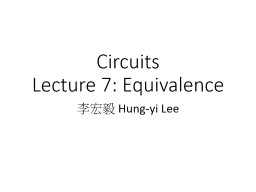

李宏毅 Hung yi Lee Textbook Chapter 21 23 Outline Concept of Equivalent networks Equivalent networks only with resistors Equivalent networks with independent sources Equivalent networks with ID: 1031449
Download Presentation The PPT/PDF document "Circuits Lecture 7: Equivalence" is the property of its rightful owner. Permission is granted to download and print the materials on this web site for personal, non-commercial use only, and to display it on your personal computer provided you do not modify the materials and that you retain all copyright notices contained in the materials. By downloading content from our website, you accept the terms of this agreement.
1. CircuitsLecture 7: Equivalence李宏毅 Hung-yi Lee
2. TextbookChapter 2.1, 2.3
3. OutlineConcept of Equivalent networks Equivalent networks only with resistorsEquivalent networks with independent sourcesEquivalent networks with controlled sources
4. OutlineConcept of Equivalent networks Equivalent networks only with resistorsEquivalent networks with independent sourcesEquivalent networks with controlled sources
5. NetworkTwo-terminal networkNetwork: Part of a complete circuit
6. Equivalent NetworkNetwork A and B are equivalent.NetworkAviNetworkBviivi-v characteristicsEquivalent networks in circuits are just like functions in programming!
7. Circuit Design is like Programmingint main () { // create array of gradesdouble quiz1_grade[50] = ……double total = 0;for (int i=0; i<50; i++){ total += quiz1_grade[i];}double avg = total / 50; print avg; return 0;} (the program for computing the average score of the first quiz)The complete circuit is the “main”.Put everything in “main” is not a good idea.
8. Circuit Design is like ProgrammingUse functionint main () { // create array of gradesdouble quiz1_grade[50] = ……print avg_score(quiz1_grade); } function avg_score(double* score){double total = 0;for (int i=0; i<50; i++){ total += score[i];}return total/50; }Define IO of a function: input: double array (scores) output: double (average score)Easy to read!Can be re-used!Understandable nameWe do not care what happens in the function.
9. Circuit Design is like ProgrammingComplete Circuit (Main)iv(IO of function)Name???Network (function)Simpler equivalent network (function name)Functioni-v characteristics
10. Benefit of Equivalent Network1. Simplify the complete circuitEasier to analyze2. Useful network can be reused just like elementsVoltage amplifier (refer to lecture 5)Current source (later)Negative Resistor (later)
11. OutlineConcept of Equivalent networks Equivalent networks only with resistorsEquivalent networks with sourcesEquivalent networks with controlled sources
12. Seriesi-v curse
13. Paralleli-v curse
14. Example 2.4Find i
15. Beyond Series and Parallel =What is Req?ReqFind i-v characteristicsWay1: Add voltage source find currentWay2: Add current source find voltage
16. Cubic PuzzleAll resistors have resistance R.A and B are the two terminals of the network. =What is Req?ReqHint: consider i-v characteristics
17. Cubic Puzzle 2(solution is at the end of the slides)
18. Infinity Puzzle=What is Req?ReqInfinite resistors(solution is at the end of the slides)
19. OutlineConcept of Equivalent networks Equivalent networks only with resistorsEquivalent networks with sourcesEquivalent networks with controlled sources
20. Sourcesi-v curseVoltage SourcesCurrent Sourcesi-v curse
21. Source Transformation
22. Source TransformationThe two circuits are equivalent.and
23. Source Transformation
24. Source Transformation
25. Why Source Transformation?Parallel
26. Why Source Transformation?SeriesBe careful about the directions of voltage and current sources
27. ExampleFind voSimply the networks by their equivalent networks
28. ExampleFind voNetwork ANetwork B
29. ExampleFind voBad idea……Do not put the target in the network to be simplified.How about ….
30. ExampleFind voTwo-terminal Network
31. ExampleFind equivalent network TypicalNetwork
32. ExampleFind equivalent network
33. Example
34. OutlineConcept of Equivalent networks Equivalent networks only with resistorsEquivalent networks with sourcesEquivalent networks with controlled sources
35. Equivalent Network with Controlled Source – Example 2.8What is the equivalent network?Find the i-v characteristicsResistorNegative Resistor!
36. Source Transformation for Controlled Sourcesvcic
37. Equivalent Network with Controlled Source – Example 2.8
38. Remind 1When computing i-v characteristics, we need reference direction of v and iWithout reference direction, we cannot really answer the i-v characteristicsLoadNetworkSourceNetworkThe current goes into the terminal with high potential.The current goes out the terminal with high potential.Network without sourcesNetwork with sources
39. Remind 2Select good networksPut a controlled source and its control variable in the same network
40. Three-terminal NetworkChapter 4.6 (out of the scope)Three-terminal network
41. Four-terminal NetworkChapter 14
42. Problem2.32, 2.36
43. Thank you!
44. Beyond Series and Parallel =What is Req?ReqFind i-v characteristics:Way1: Add voltage source find currentWay2: Add current source find voltageAns:1.1K
45. Cubic PuzzleAll resistors have resistance R.A and B are the two terminals of the network. =What is Req?Req
46. Cubic Puzzle 2http://e2e.ti.com/blogs_/archives/b/thesignal/archive/2013/03/18/resistor-puzzle-solution-and-a-rant-on-schematics.aspx?DCMP=scblog&HQS=hpa-pa-opamp-thehub-20140129-thesignal-20130318-en
47. Infinity Puzzle=What is Req?ReqInfinite resistorshttps://www.youtube.com/watch?v=MgN7h1z5bMQ (the answer in the video is not correct)
48. Problem - Answer2.322.36(a) What if ?(b) (5 – 0.5)K(c)
49. Brain Teaserhttp://rochester.ieee.org/files/2014/03/Newsletter_4-2014.pdf
50. Acknowledgement感謝 范廷瀚 (b02)糾正 Infinity Puzzle 的錯誤答案